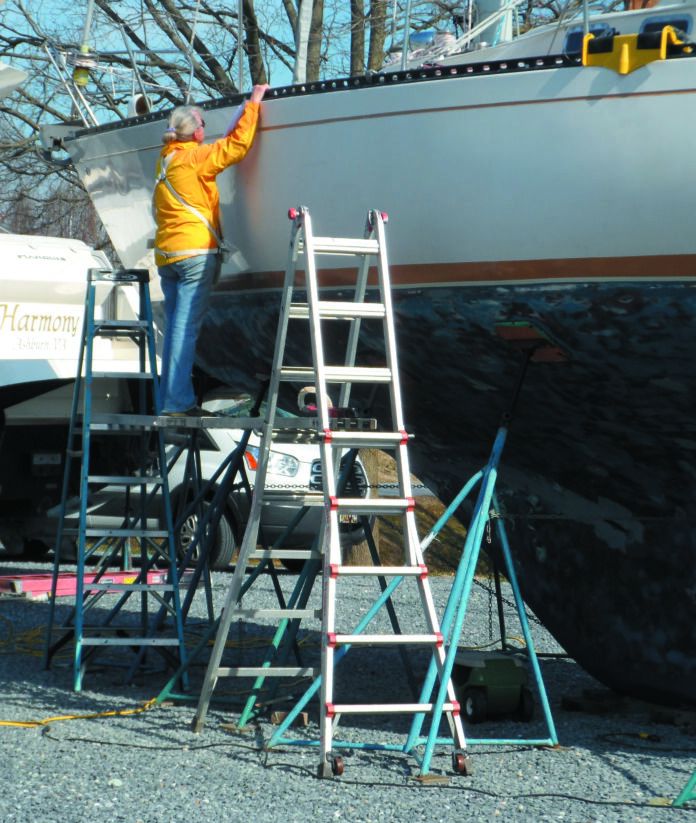A few years ago, while sitting on the gravel applying fairing compound to my keels (see “Fairing the Keels,” July 2016), I heard a scratching sound, a yelp of profanity, a clatter and a thud. A boater in the next row had been caulking the toe rail from a ladder, he overreached, and the ladder squirted out. Several of us ran over to find the man in obvious pain. Dismissing our suggestions to seek medical assistance, he insisted on getting back to work. After all, he was launching in few days, the reason he had been rushing in the first place. But when he attempted to put the ladder back up, he found he couldn’t. He puttered about for a few minutes, by which time the adrenaline had worn off and the extent of his injuries became more clear. He announced he was headed to the clinic but would accept no help. The boat stayed on stands the rest of the season, after which it went on the market. The injuries to his back and shoulder were enough to end his sailing days.
Spring is here, the boat yards are sprouting ladders, and we could all use a reminder that gravity never rests.
LADDER ANGLE
Place straight ladders at the proper angle. According to OHSA and ladder manufacturers, the correct angle is 75 degrees, or a 4:1 ratio. Any steeper, and the bottom can kick out as you reach the top. As a rough gauge, stand at the base of the ladder with your arms extended.
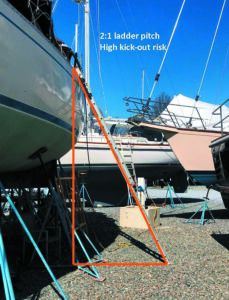
You should be able to grasp the rungs comfortably with your elbows slightly bent. You should be in-balance when climbing the ladder. Any steeper and the ladder may pull away from the boat as you pull out or slide to the side because friction against the top is too little. Any less and the base will kick out when you reach the top, particularly if placed on a slippery surface or if the ladder feet walk backwards while you are working. Ladders are commonly set at a lower angle because it is easier to carry something and it gives more leverage to push against the boat, but both of these are risk factors.
TIE IT OFF
Secure the ladder to a stanchion or toe rail with a rope lashing the first time you ascend. In the case of a stepladder used to gain access to a transom boarding ladder, tie them together before you climb. You will recover the time spent every trip by moving more quickly and securely. A smart habit is to leave a 4-foot length of 5/16-inch rope attached to the top rung of the ladder as a reminder.
Do not tie a ladder, scaffold, cover, or anything else to boat stands. They can safely support a boat under enormous loads, but only if they are not pulled out or to the side. Safety chains secure them against spreading, but these are NOT intended for any other purpose. Falling is bad, but having the boat land on you is worse.
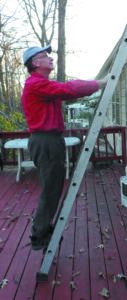
NO LADDERS ON DECK
Most boatyards prohibit climbing the mast by any means while the boat is hauled out. A falling climber can exert a considerable side force at the end of a long lever arm. There are also liability concerns.
It is conceivable that you might need to access a transom radar tower or something on the arch. A step ladder suitable for the task can work, remembering that stepladders may ONLY be used on surfaces that are completely flat and without complex curvature. Tie the feet off in all directions, tie off the top if possible, and remember that it’s a long way to the ground, probably on your head. Such tasks are only to be undertaken with great seriousness.
USING A-FRAME LADDERS
A-frame ladders can be very stable when used properly. Often they are not. Don’t lean an A-frame ladder as a plain ladder. If the second set of feet touch the ground they will lever the main feet off the ground and the ladder may slide out.
BEWARE OF LADDER WRACKING
A-frame ladders are subject to instability if torqued (wracked), and we believe this caused the fall described in the introduction. Climbing the ladder with tools in his right hand, he pulled himself upward with his free arm, in an effort to keep his body vertical. This imposed a torque about a vertical axis to the ladder, unweighting and lifting one of the rear legs, and allowing the other leg to skid on the gravel, resulting in the lightweight ladder becoming twisted or “wracked” in the direction of the applied torque.
When his foot moved to a higher step, the ladder shifted back to the leg that has now both relocated and lifted. Near the ground this is a minor shift, barely noticeable, but near the top of a ladder the shift is greater, and a sudden correction by the climber will make the ladder shoot sideways.
Laboratory testing has shown that using an 8-foot ladder, a one-inch of leg lift is sufficient to cause this. Prevention includes placing the ladder on level ground, tying the ladder off, avoiding lightweight ladders, not carrying tools, not climbing to the top 2 steps, and not reaching outside the rails. OSHA lists ladder wracking as a leading cause of falls from A-ladders.
Don’t use a too-short ladder. You should not stand on the top two rungs of any ladder type.
OVERREACHING
In a perfect world you would never reach outside the rails of a ladder. Doing so changes all of the force vectors and can make any ladder unstable. If you must (and you will), strict adherence to tying off the ladder is required. If working along the side of the boat, get a second ladder and plank, and set up a scaffold.
PAD THE LADDER RAILS
No one wants to lay a raw ladder against a vanished, gelcoat, or even aluminum toe rail. Wrapping the ladder in carpet, towels, or even taping on a pool noodle will work, but they are cumbersome, temporary, and worst of all, slippery. Instead, add something with grip that will always be there.
Rubber-back carpet runner, glued rubber-side out, does the trick. It takes only minutes to cut two 1” x 30” strips with a hit knife, run a bead of urethane sealant (we like Loctite PL S40 for this— it bonds well to plastics and aluminum, and it’s cheap), and slap the strips on the ladder. A thick layer of fabric-reinforce rubber would last longer and any high friction coating or material will do. The added thickness typically does not interfere with the telescoping of extension ladder, but check first.
Most high friction materials get slippery after long exposure to weather, so figure on re-doing it every few years.
TOOL BAG
Set this up ahead of time or you will carry stuff up the ladder. A rigger’s bag designed for hauling works well. A carabiner on the rope permits quick changes.
SCAFFOLDS
The complexities of this topic go far beyond a boat magazine article, so we’ll confine ourselves to just a few common styles.
HORSE SCAFFOLD
A pair of well-braced sawhorses can be superior to sticking walkboards through A-frame ladders, particularly when only one elevation is needed and it is no more than 3 feet high. They have a wider base than a ladder and are more stable. They stack for storage in your shed, and make a worktable by throwing a piece of plywood on top (install cleats on the underside prevent sliding). This is our favorite option for working on smaller boats.
A-FRAME LADDERS AND ARTICULATED LADDERS
If your intention is to use one for scaffold supports, look for one with legs or leg braces at least 24 inches wide. Articulated ladders should ONLY be used in the configuration identified on the ladder frame.
WALKBOARDS
OSHA has tables, depending on span and loading, but a 2×10 is generally acceptable for light duty use (meaning one worker) up to an 8-foot span. The lumber must be scaffold grade, which basically means select grade lumber with very few knots.
Putting cleats on the underside so they can’t slide out is smart. Test at lowest level first, with a little light bouncing. If there is more than a few inches of deflection or any creaking noises, get a better board.
Sanding dust will make decks and walkboards slippery. Although not completely avoidable, make every effort to minimize extension cords and materials on ladders and walkboards.
FALL PROTECTION ON SCAFFOLDS
In general, fall protection in the form of railings or rope and harness is required above 6 feet in elevation. However, as OSHA describes in its construction standards, it only requires fall protection and railings for scaffolds over 10 feet:
(1) Each employee on a scaffold more than 10 feet (3.1 m) above a lower level shall be protected from falling to that lower level. Paragraphs (g)(1) (i) through (vii) of this section establish the types of fall protection to be provided to the employees on each type of scaffold. Paragraph (g)(2) of this section addresses fall protection for scaffold erectors and dismantlers. Note to paragraph (g)(1): The fall protection requirements for employees installing suspension scaffold support systems on floors, roofs, and other elevated surfaces are set forth in Subpart M of this Part.
(i) Each employee on a boatswains’ chair, catenary scaffold, float scaffold, needle beam scaffold, or ladder jack scaffold shall be protected by a personal fall arrest system . . .
CLEAR WORK AREA
Keep the area clear. Don’t stack materials near or under ladders or scaffolding. You don’t want to trip coming or going, and though falling onto level gravel from a height is bad, falling onto a pile of stuff is much worse.
What are the most common causes of ladder accidents? Fifty percent involve carrying something. The 65-74 age group has the most falls; younger people are more agile and older people stay off ladders. Missing the last step is a factor in most falls; always climb all the way to the ground with both hands and both feet. I witnessed a compound ankle dislocation inside a work boot. The cause? He skipped the last step, while carrying something, and his ankle turned on something he left at the base of the ladder. He missed 8 months of work and never walked right again.
Rig a temporary high lifeline if much work is to be done on-deck (see “Raising the Bar on Lifelines,” July 2016). Not all boatyard falls are from ladders.
CONCLUSIONS
More than a few companies have banned the use of ladders after too many falls. A little too much haste, a reach too far to one side, and serious injury is only seconds away. Other than sailing, rock and ice climbing are my favorite hobbies, but I still give ladders great respect. They are portable, convenient ways to get off the ground. Use them safely.
You don’t have to spend very much time in any DIY boatyard to realize that a large number do-it-yourselfers don’t give very much thought to their personal safety. Even some pros engage in practices that would make any risk manager reach for his blood pressure medication. Having a solid perch is particularly important as we age, when balance suffers and a fall can be catastrophic.
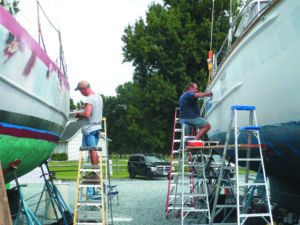
1. A scaffolding using 2 x 10 planks as walk boards is acceptable, but the lack of basic PPE like gloves and vapor protection when using high solvent paints isn’t smart. The bigger risk are the flip flops that the man on the right is wearing. Sandals are unacceptable in the boatyard.

2. Know your limits. An A-frame ladder is easy to move along a boat when scaffolding is not available. However, the risk factor goes up when you are working with power tools. Fortunately, this worker is only using the first rung.

3. Piling buckets and tools and cords on the scaffolding is asking for trouble. The scaffold should be as free as possible of any trip hazards, especially when using power tools.

4. Padding the ladder not only protects the hull from scuffs and scratches, it keeps the ladder from slipping. This ladder is well secured to the boat.
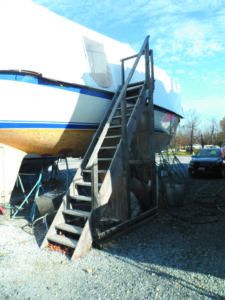
5. Stairs are much safer than ladders when a lot of heavy or bulky materials will be transferred aboard. Some yards have rolling stairs which can serve the same purpose when properly blocked to prevent them from rolling.
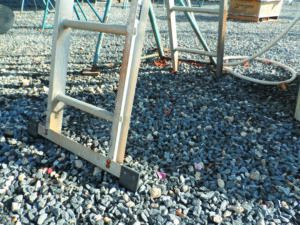
6. A wide base is a big advantage. Movie pratfalls feature a ladder falling backward, but the base slipping on an unstable surface is a serious concern in the boatyard.

7. This ladder is too steep for safe climbing. Because there is not enough rail pressure against the boat, it is at risk of falling over backwards or sliding sideways.



































